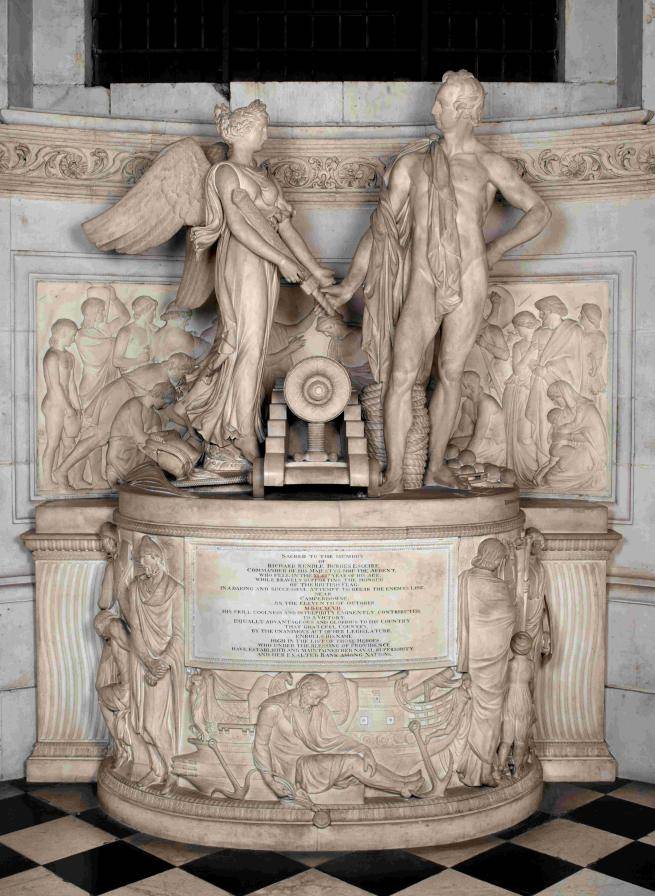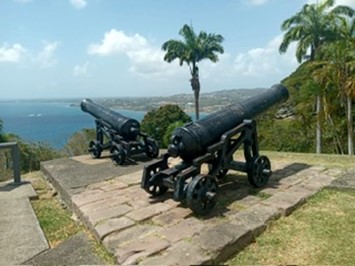Richard Rundle Burges

Image courtesy of Pantheons – Sculpture at St Paul's Cathedral (c.1796–1916) (york.ac.uk)
Richard Rundle Burges
Part of War and resistance in the Caribbean: The monuments at St Paul's: A digital trail produced in collaboration with SV2G.
The following entry has been researched and written in collaboration with members of SV2G.
Note: We are only at the start of the journey toward centring the Caribbean voice in the Revolutionary Wars. The campaigns have traditionally been documented without a focus on the impact on local populations. Although the archival records offer limited information and this area of historical study is under-developed, our project raises awareness about the activities of the British campaigns in the Caribbean and their lasting legacies, and introduces visitors to a number of Caribbean heroes.

This sculpture, the first war monument to be erected in the Cathedral, commemorates a famous battle in the war against Revolutionary France. In the North Sea near Camperdown off the coast of Holland, Captain Richard Burges was killed, physically split in half by a chain-shot from a cannon. Burges was the highest-ranking casualty in this battle.
The cannon on the monument is not only a reminder of Burges’ cause of death but also of the realities of naval combat at the time. Burges served in the British navy in the Caribbean during the American Revolutionary wars and was part of the British invasions of Saint Lucia, Grenada and Martinique from 1778 to 1780. Cannons were a significant part of those invasions. British ships would approach an island, firing cannons at the defensive forts, which would return fire. A landing force would then try to take possession of the cannons and turn them against the forts. Cannons from the eighteenth century, still found on forts around the Caribbean such as Fort George in Trinidad and Tobago, are physical reminders to this day of the legacy of war in the region.
The monument also depicts the HMS Ardent commanded by Captain Burges at Camperdown, a 64–gun ship originally designed for the British East India Company, but purchased by the Royal Navy for service as a warship when the French Revolutionary Wars broke out. The sculpture’s imagery and inscription highlight Britain’s ‘naval superiority’. But they hide the complex realities of this maritime history. The Atlantic Ocean was not just an arena for the British to showcase its naval capabilities; it was the place upon which Western powers imposed their imperial ambitions, and the site of displacement, dislocation, enslavement, and indeed death, for millions of African captives sent to work as slaves in the Americas. Between the 16th and 19th centuries more than twelve million Africans were forced across the Atlantic Ocean in a harrowing voyage which has become known as the Middle Passage, during which many died from appalling conditions, disease, ill treatment and suicide. Black naval seamen were also used in the engagement of war by the British Royal Navy during the Revolutionary Wars, recruited both as sailors and to provide maintenance and row the ships in the galleys.
The sculptor of this monument, Thomas Banks, was in fact critical of the imperialist attitudes asserted by the St Paul’s monuments. Long a critic of aristocratic privilege and material greed, he was strongly opposed to Britain’s war against Revolutionary France, and associated himself with radical institutions that sought democratic reforms of British politics, as well as the anti-slavery movement. These sympathies led to his arrest in 1794 on suspicion of treason. Banks described the monuments at St Paul’s as commissions ‘to the memory of those heroes who have carried the national glory to the greatest height in destroying the greatest numbers of mankind’.

Listen to an audio-recording of this text read by a member of SV2G. Sound recording by Marlon Lewis, Life in Frames.
For detailed information about this monument, visit the Pantheons: Sculpture at St Paul's Cathedral website.

War and resistance in the Caribbean
The monuments at St Paul's
Explore the full digital trail produced in collaboration with SV2G.




